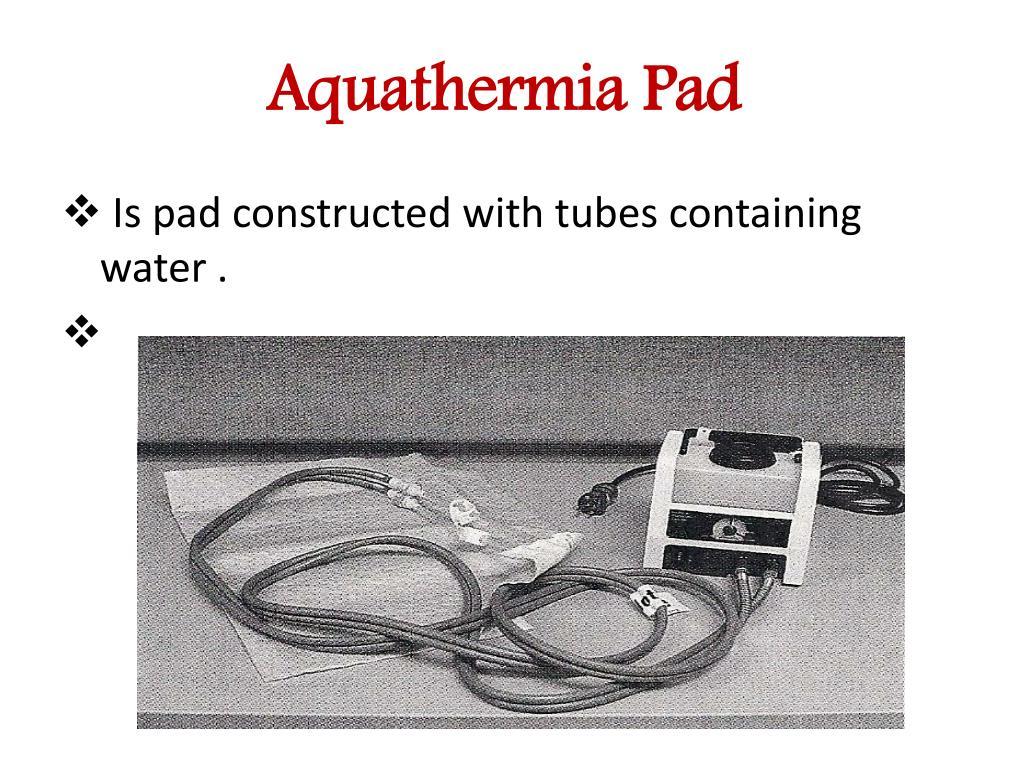What safety factors should be considered when using an Aquathermia pad unit for a patient? (Select all that apply)
Inspecting the plug and cord for cracks or fraying
Securing the pad to the patient
Instructing the patient not to sleep on the pad
Assisting the patient to lie on top of the pad
Using a thermometer to check the temperature of the pad
Correct Answer : A,B,C,E
Choice A rationale
Inspecting the plug and cord for cracks or fraying is essential to prevent electrical hazards and ensure the safety of both the patient and healthcare staff.
Choice B rationale
Securing the pad to the patient helps to maintain the correct position and prevent burns or other injuries from improper pad placement.
Choice C rationale
Instructing the patient not to sleep on the pad is important because prolonged, direct contact with the heat source can cause burns, especially if the patient is immobile or has sensory deficits.
Choice D rationale
Assisting the patient to lie on top of the pad is not recommended as it can lead to burns due to increased temperature exposure in one area.
Choice E rationale
Using a thermometer to check the temperature of the pad ensures that it is within a safe range for application to the patient's skin, preventing burns.

Nursing Test Bank
Naxlex Comprehensive Predictor Exams
Related Questions
Correct Answer is C
Explanation
Choice A rationale
When administering a hot soak treatment, it is crucial to soak only the affected area to provide targeted heat therapy. This localized approach helps to increase blood flow, reduce pain, and promote healing in the specific area that requires treatment. Soaking only the affected area also minimizes the risk of overheating and potential burns to other parts of the body.
Choice B rationale
While positioning the patient comfortably is important for any treatment, it is not the most critical aspect of a hot soak treatment. Comfort should always be considered, but the primary goal of the hot soak is to apply heat to the affected area to aid in healing. Therefore, ensuring that only the affected area is soaked takes precedence over general patient comfort in this context.
Choice C rationale
Monitoring the temperature of the water is the most important aspect of a hot soak treatment. The water must be warm enough to be therapeutic but not so hot as to cause burns or discomfort. This ensures the treatment is both safe and effective1.
Choice D rationale
Checking the patient’s skin integrity is important, especially if the patient has a condition that affects skin sensitivity, such as diabetes. However, the immediate concern during a hot soak treatment is to monitor the temperature to prevent injury.
Correct Answer is A
Explanation
Choice A rationale
Moisture from incontinence can compromise skin integrity and create a favorable environment for bacterial growth, increasing the risk of infection and skin breakdown.
Choice B rationale
While a wet bed may be uncomfortable, it does not exert greater pressure that would lead to skin breakdown or infection.
Choice C rationale
Shearing can occur from moving a patient on any surface; however, wet sheets do not inherently increase the likelihood of shearing.
Choice D rationale
Repositioning the patient is necessary for comfort and to prevent pressure ulcers, but it is not a direct cause of skin breakdown or infection due to incontinence.
Whether you are a student looking to ace your exams or a practicing nurse seeking to enhance your expertise , our nursing education contents will empower you with the confidence and competence to make a difference in the lives of patients and become a respected leader in the healthcare field.
Visit Naxlex, invest in your future and unlock endless possibilities with our unparalleled nursing education contents today
Report Wrong Answer on the Current Question
Do you disagree with the answer? If yes, what is your expected answer? Explain.
Kindly be descriptive with the issue you are facing.
